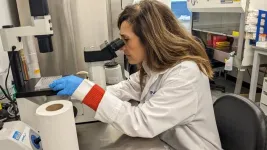PRESENTATIONS and POSTER SESSIONS
(*All abstracts are under embargo until the below listed times*)
Sunday, February 11, 2024
FGR prevention: Is there a role for aspirin, heparin, statins, and others
8:50 – 9:10 a.m. ET
Maryland Ballroom B, Ballroom Level, Gaylord National Resort & Convention Center
Presenter: Joanne Stone, MD, MS, Professor and System Chair of the Raquel and Jaime Gilinski Department of Obstetrics, Gynecology and Reproductive Science at the Icahn School of Medicine at Mount Sinai
• The presentation will cover treatment and prevention of fetal growth restriction.
Panel Discussion with Q&A
9:30 – 10:00 a.m. ET
Maryland Ballroom B, Ballroom Level, Gaylord National Resort & Convention Center
Panelist: Joanne Stone, MD, MS, Professor and System Chair of the Raquel and Jaime Gilinski Department of Obstetrics, Gynecology and Reproductive Science at the Icahn School of Medicine at Mount Sinai
• The panel will cover topics including fetal growth restriction, best practices, and the future of obstetrics treatment and care.
Monday, February 12, 2024
Oral Plenary Session I and Late-Breaking
3:45– 6:00 p.m. ET
Potomac Ballroom, Ballroom Level, Gaylord National Resort & Convention Center
Co-moderator: Joanne Stone, MD, MS, Professor and System Chair of the Raquel and Jaime Gilinski Department of Obstetrics, Gynecology and Reproductive Science at the Icahn School of Medicine at Mount Sinai
• The various presentations will cover a range of topics including fetal structural anomalies, maternal sepsis, postpartum hemorrhage, and COVID infection during pregnancy.
Tuesday, February 13, 2024
Poster Session 1
(154) Antenatal late preterm steroids in twin gestations
10:30 a.m. – 12:00 p.m. ET
Presenter: Sara Edwards, MD, Maternal-Fetal Medicine Fellow at Mount Sinai Hospital
• The use of antenatal steroids in the late preterm period (34+0 to 36+6 weeks gestation) to improve neonatal outcomes is now common. The objective of this study is to evaluate maternal and neonatal outcomes in twin gestations who received antenatal steroids in the late preterm period.
(165) Machine Learning for the Prediction of Surgical Morbidity in Placenta Accreta Spectrum
10:30 a.m. – 12:00 p.m. ET
Co-authors: Thomas Owens, MD, Maternal-Fetal Medicine Fellow at Mount Sinai West; Henri M. Rosenberg, MD, Maternal-Fetal Medicine Fellow at Mount Sinai Hospital; Nicola F. Tavella, MPH, Clinical Research Program Director in the Raquel and Jaime Gilinski Department of Obstetrics, Gynecology and Reproductive Science at the Icahn School of Medicine at Mount Sinai; and Angela Bianco, MD, Director of Maternal-Fetal Medicine and Professor in the Raquel and Jaime Gilinski Department of Obstetrics, Gynecology and Reproductive Science at the Icahn School of Medicine at Mount Sinai
• This study created a machine-learning model to identify variables that would aid in the prediction of surgical morbidity in cases of placenta accreta spectrum, or the condition when the placenta does not detach spontaneously after delivery and cannot be forcibly removed without causing bleeding.
Poster Session 2
(433) Does the Timing of Resolution of Low Placentation Affect the Risk of Postpartum Hemorrhage?
3:30 PM – 5:00 p.m. ET
Co-authors: Henri M. Rosenberg, MD, Maternal-Fetal Medicine Fellow at Mount Sinai Hospital; Angela Bianco, MD, Director of Maternal-Fetal Medicine and Professor in the Raquel and Jaime Gilinski Department of Obstetrics, Gynecology and Reproductive Science at the Icahn School of Medicine at Mount Sinai; and Chelsea A. DeBolt, MD, Assistant Professor in the Raquel and Jaime Gilinski Department of Obstetrics, Gynecology and Reproductive Science at the Icahn School of Medicine at Mount Sinai
• Low placentation is defined as placenta previa or low-lying placenta, and is associated with increased risk of postpartum hemorrhage, both if resolved during prenatal care or persistent until delivery. This study investigates whether the gestational age at which low placentation resolves is associated with increased odds of postpartum hemorrhage.
(573) Does the addition of MRI in antenatal management of suspected PAS impact maternal surgical outcome?
3:30 – 5:00 p.m. ET
Presenter: Henri M. Rosenberg, MD, Maternal-Fetal Medicine Fellow at Mount Sinai Hospital
Co-authors: Nicola F. Tavella, MPH, Clinical Research Program Director in the Raquel and Jaime Gilinski Department of Obstetrics, Gynecology and Reproductive Science at the Icahn School of Medicine at Mount Sinai; Thomas Owens, MD, Maternal-Fetal Medicine Fellow at Mount Sinai West; and Angela Bianco, MD, Director of Maternal-Fetal Medicine and Professor in the Raquel and Jaime Gilinski Department of Obstetrics, Gynecology and Reproductive Science at the Icahn School of Medicine at Mount Sinai
• Pre-birth diagnosis of placenta accreta spectrum is difficult and sometimes uncertain. In the United States, up to 50 percent of patients with placenta accreta spectrum are never diagnosed until the time of delivery. Diagnosis of the condition at the time of delivery can result in poor maternal outcomes. The objective of this study is to assess if the addition of an MRI before birth in suspected placenta accreta spectrum resulted in improved surgical outcomes.
(614) Childhood Opportunity Index and Severe Morbidity in a cohort complicated by Placenta Accreta Spectrum Disorder
3:30 – 5:00 p.m. ET
Presenter: Nicola F. Tavella, MPH, Clinical Research Program Director in the Raquel and Jaime Gilinski Department of Obstetrics, Gynecology and Reproductive Science at the Icahn School of Medicine at Mount Sinai
Co-authors: Henri M. Rosenberg, MD, Maternal-Fetal Medicine Fellow at Mount Sinai Hospital; and Thomas Owens, MD, Maternal-Fetal Medicine Fellow at Mount Sinai West; and Angela Bianco, MD, Director of Maternal-Fetal Medicine and Professor in the Raquel and Jaime Gilinski Department of Obstetrics, Gynecology and Reproductive Science at the Icahn School of Medicine at Mount Sinai
• The objective of this study is to evaluate the association of the childhood opportunity index with severe maternal and neonatal morbidity in a sample of cases complicated by placenta accreta spectrum in New York City. Childhood opportunity index is a complex measure evaluating social and built environment regarding individual capacity for development.
Wednesday, February 14, 2024
Poster Session 3
(653) Timing of antenatal placenta accreta spectrum diagnosis and impact on clinical outcomes: a multicenter study
8:30 – 10:00 a.m. ET
Co-authors: Henri M. Rosenberg, MD, Maternal-Fetal Medicine Fellow at Mount Sinai Hospital; Thomas Owens, MD, Maternal-Fetal Medicine Fellow at Mount Sinai West; Nicola F. Tavella, MPH, Clinical Research Program Director in the Raquel and Jaime Gilinski Department of Obstetrics, Gynecology and Reproductive Science at the Icahn School of Medicine at Mount Sinai; and Angela Bianco, MD, Director of Maternal-Fetal Medicine and Professor in the Raquel and Jaime Gilinski Department of Obstetrics, Gynecology and Reproductive Science at the Icahn School of Medicine at Mount Sinai
• This study assesses the impact of timing of antenatal diagnosis on management and outcomes in patients with placenta accreta spectrum.
(745) Mode of delivery in FGR by EFW<10% vs. EFW≥10%ile and AC<10%ile undergoing trial of labor
8:30 – 10:00 a.m. ET
Presenter: Henri M. Rosenberg, MD, Maternal-Fetal Medicine Fellow at Mount Sinai Hospital
Co-authors: Sara Edwards, MD, Maternal-Fetal Medicine Fellow at Mount Sinai Hospital; Calvin E. Lambert, Jr., MD, Assistant Professor in the Raquel and Jaime Gilinski Department of Obstetrics, Gynecology and Reproductive Science at the Icahn School of Medicine at Mount Sinai; Angela Bianco, MD, Director of Maternal-Fetal Medicine and Professor in the Raquel and Jaime Gilinski Department of Obstetrics, Gynecology and Reproductive Science at the Icahn School of Medicine at Mount Sinai; and Chelsea A. DeBolt, MD, Assistant Professor in the Raquel and Jaime Gilinski Department of Obstetrics, Gynecology and Reproductive Science at the Icahn School of Medicine at Mount Sinai
• Per 2020 Society for Maternal-Fetal Medicine guidelines, fetal growth restriction is diagnosed by estimated fetal weight < 10%ile or abdominal circumference < 10%ile despite estimated fetal weight. The objective of this study is to investigate the difference in mode of delivery in patients undergoing a trial of labor between estimated fetal weight < 10%ile versus abdominal circumference < 10%ile but estimated fetal weight ≥10%ile. This will determine if there are increased odds of cesarean delivery in pregnancies complicated by fetal growth restriction.
Poster Session 4
(962) Social determinants of health impact the development of new-onset postpartum hypertension
1:00 – 2:30 p.m. ET
Presenter: Camila Cabrera, MD, Maternal-Fetal Medicine Fellow at Mount Sinai Hospital
Co-authors: Sheela Maru, MD, MPH, Assistant Professor in the Raquel and Jaime Gilinski Department of Obstetrics, Gynecology and Reproductive Science at the Icahn School of Medicine at Mount Sinai; Katharine McCarthy, MPH, PhD, Assistant Professor in the Raquel and Jaime Gilinski Department of Obstetrics, Gynecology and Reproductive Science at the Icahn School of Medicine at Mount Sinai; Jill A. Berkin, MD, Assistant Professor in the Raquel and Jaime Gilinski Department of Obstetrics, Gynecology and Reproductive Science at the Icahn School of Medicine at Mount Sinai; and Lauren Ferrara, MD, Assistant Professor in the Raquel and Jaime Gilinski Department of Obstetrics, Gynecology and Reproductive Science at the Icahn School of Medicine at Mount Sinai
• Hypertension that is diagnosed postpartum is understudied. Although more commonly diagnosed in women with hypertensive disorders of pregnancy, it can occur after delivering a baby. There are no guidelines for blood pressure surveillance after normotensive pregnancies; therefore, data is limited on the incidence and risk factors for new-onset hypertension diagnosed postpartum. This study prospectively examines incidence and risk factors for hypertension diagnosed postpartum, and the impact of social determinants of health.
(1099) Placenta accreta spectrum (PAS) diagnosis timing and its effect on maternal and neonatal outcomes
1:00 – 2:30 p.m. ET
Presenter: Thomas Owens, MD, Maternal-Fetal Medicine Fellow at Mount Sinai West
Co-authors: Henri M. Rosenberg, MD, Maternal-Fetal Medicine Fellow at Mount Sinai Hospital; Nicola F. Tavella, MPH, Clinical Research Program Director in the Raquel and Jaime Gilinski Department of Obstetrics, Gynecology and Reproductive Science at the Icahn School of Medicine at Mount Sinai; and Angela Bianco, MD, Director of Maternal-Fetal Medicine and Professor in the Raquel and Jaime Gilinski Department of Obstetrics, Gynecology and Reproductive Science at the Icahn School of Medicine at Mount Sinai
• Expert opinion suggests that pre-birth diagnosis results in improved maternal and neonatal outcomes. This study retrospectively compares perinatal outcomes in pre-birth diagnosed placenta accreta spectrum cases versus those identified at the time of delivery.
###
About the Mount Sinai Health System
The Mount Sinai Health System is one of the largest academic medical systems in the New York metro area, with more than 43,000 employees working across eight hospitals, over 400 outpatient practices, over 300 labs, a school of nursing, and a leading school of medicine and graduate education. Mount Sinai advances health for all people, everywhere, by taking on the most complex health care challenges of our time — discovering and applying new scientific learning and knowledge; developing safer, more effective treatments; educating the next generation of medical leaders and innovators; and supporting local communities by delivering high-quality care to all who need it.
Through the integration of its hospitals, labs, and schools, Mount Sinai offers comprehensive health care solutions from birth through geriatrics, leveraging innovative approaches such as artificial intelligence and informatics while keeping patients’ medical and emotional needs at the center of all treatment.
For more information, visit https://www.mountsinai.org or find Mount Sinai on Facebook, Twitter and YouTube.
END








